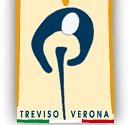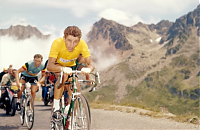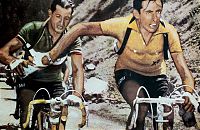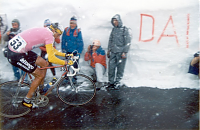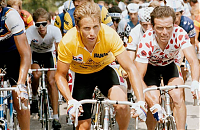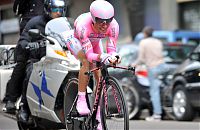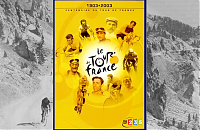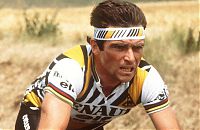John Hathaway - Cyclist

Photo: John Hathaway and Vanessa Bridge riding along on the Champs-Élysées 1983
By 1986 John was getting itchy feet again and he planned another Round the World epic. This time aiming to climb the World’s highest roads en route. He left Vancouver on the last day of Expo and headed east to the Continental Divide and headed south from there. His 62nd birthday on January 13, 1987, found him clambering up the world’s highest road out of Lima, Peru. Unfortunately, in Argentina he was hit by a truck, damaging some vertebrae and was in hospital for some weeks. They have a very good cost saving scheme there. The medical care is free but patients’ families are expected to look after them. John always had fond memories of the Argentinian family that looked after him.
The damaged back left him a good deal more wizened than he had been. But he still managed to cock a leg over a saddle and cover some considerable distances. In 1990 he sold up everything here and headed back to England. But things didn’t work out for him there and before long he was on the road again. He started PBP ’91 having qualified in UK events. But his free wheel packed up on him and he was stranded very early in the event.
—
Passport Theft Sends Cyclist Through SL
By Jack Fenton
THE SALT LAKE TRIBUNE March 12 1993
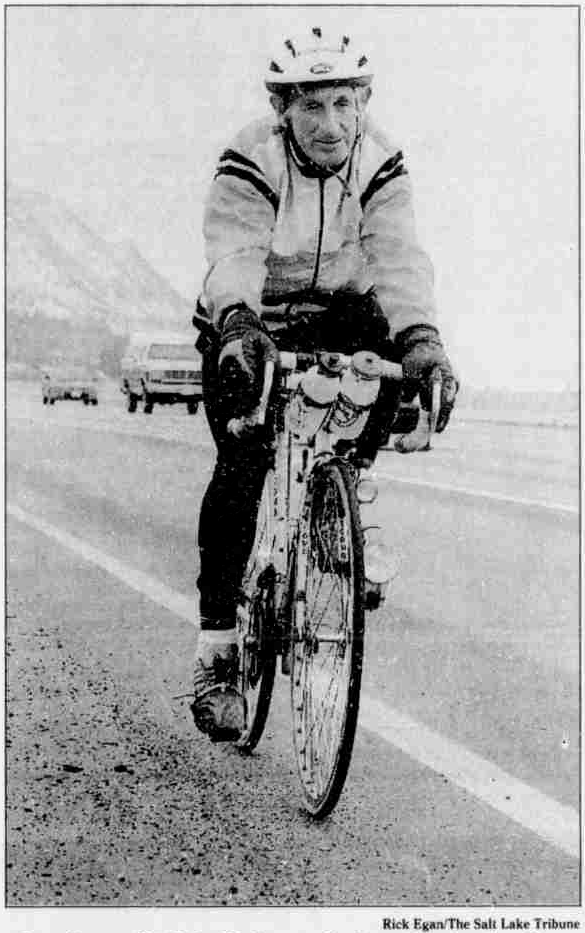
If John Hathaway’s passport had not been stolen in Florida he might not have been in Salt Lake City this week.
The journey to get a replacment led the 68-year old Vancouver British Columbia resident to change the route of his latest bicycle tour, a 27000-mile odyssey started in upstate New York in October 1991.
If all goes as scheduled the one-man tour will end at his Canadian home next October.
By then, the man who retains a British accent 40 years after leaving the isles, figures he will have cycled more than 370.000 miles over 50 years.
Mr Hathaway said the challenge is prompting him to record a mileage total roughly equal to circling the Earth’s equator 15 times.
“I’ve seen the whole world from the seat of a bicycle” he said.
To learn about people Mr Hathaway said he parks the bike at a house or farm and asks permission to pitch his tent.
In Salt Lake City Mr Hathaway is staying with Carl Ehrman whose home is listed by the Legion of American Wheelmen as a hospitality house.
“I’ve seen the country, I’ve met the people” he said. The totals: Mr Hathaway has met 150 people and made 150 friends
Mr Hathaway scoffs at the dangers of bicycle travel “An accident can happen anywhere” he said relating the story of a friend who swapped his bike for a go-cart after being hit by a car, “He was killed in a carting accident”.
He’s been in accidents too Mr Hathaway said.
He broke a hip in 1972. And a 1987 collision in Argentina broke his back, compressed two disks and forced him to give up his job — making machine-shop drawings for engineers.
The Passport?
“That’s another story” he said. But Mr Hathaway will get a new one in Minneapolis when the trip continues.
—-
John William Hathaway: January 13, 1925 – June 6, 1997.
The Tour du St-Laurent cycliste

The Tour du St-Laurent cycliste
For the monthly “No-Click” club (i.e. vintage bicycles related) here in Toronto, I did a presentation on the Tour du St-Laurent cycliste (TDSL). The information is based on a book by the wife of the Tour’s founder: “Le tour du St-Laurent cycliste, Souvenirs d’une épopée…” by Madeleine Barbeau Guillou, la Plume d’Oie Édition, 2001.
The TDSL was a stage-type amateur road race held 12 times in Québec between 1954 and 1965. The race varied in distance between 350 miles and 1000 miles, during 2 to 8 days, and attracted approximately 50 racers on average. It roughly followed the St-Laurence river (north and south shore) from Québec City to Montréal and back.
The founder of the TDSL was Yvon Guillou, a Frenchman from Brittany (born 1927) who emigrated to Canada in 1951. A keen cyclist, he won the Québec-Montréal classic race in 1952 and a few other races. He would participate in the first four editions of the TDSL.

Lucy Pittaway

One of the Uk’s rising stars in the art world was once again chosen as the official artist for this year’s Tour de Yorkshire.
Richmond, UK-based pastel artist Lucy Pittaway, was chosen by race officials to create a series of art pieces designed to capture the spirit and imagination of the Yorkshire people, as they celebrate the region’s biggest annual race.
Last year, Pittaway took to her canvass to create a series entitled Hills, Dales and Woolly Tails, which depicted the excitement, endurance and tenacity of the race, set against the unique Yorkshire backdrop with eager crowds of fans accompanied with fluffy sheep, spurring the riders on.
source
Retro Cyclists

The proper way to go on a bike ride. A stop for Food Wine And Coffee––Cucina Vino Caffe–– fuel for the road.
Bloomer Girl

French Racing Cyclist Marie Tual Wearing Bloomers on a Racing Bike in 1896 or in 1897.
Many of these cycling pioneers adopted an updated version of the old “bloomer” outfit which allowed for more freedom of movement — and less risk of their clothes becoming caught up in the chain or wheels.
“If women ride the bicycle or climb mountains, they should don a costume which will permit them the use of their legs,” Suffragist Susan B. Anthony has been quoted as saying. “My one word about the ‘bloomers’ or any other sort of dress, is that every woman, like every man, should be permitted to wear exactly what she chooses.”
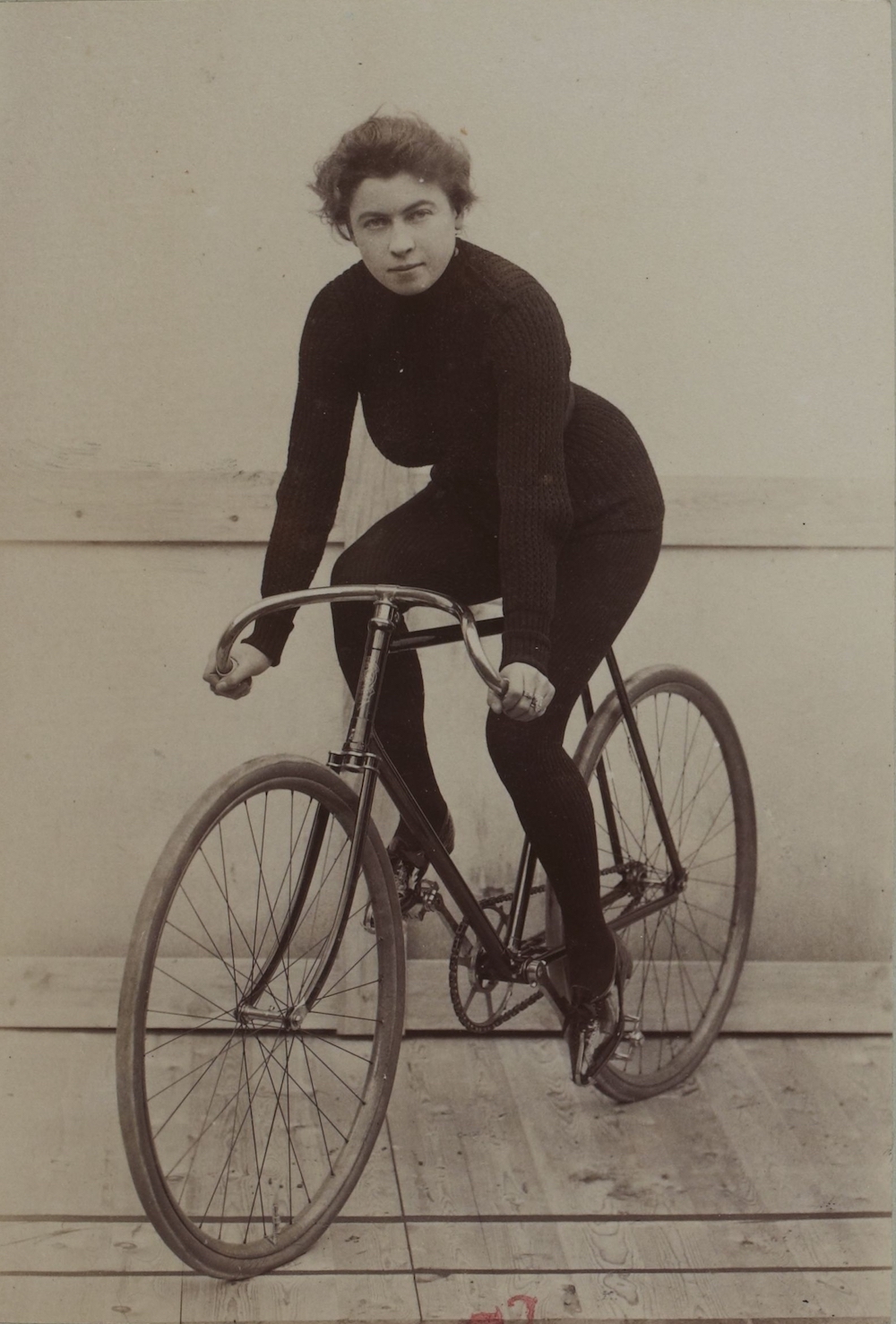

Racing gear.
William Bertram "Bill" Hurlow

William Bertram “Bill” Hurlow was considered the “builder’s builder.”
Bill Hurlow died Sunday, Feb 28th, 2010 in Canterbury Hospital.
A friend and riding companion, John Hunt reports: “I think he knocks all other frame builders into a cocked hat! He’s done so much & his memory is incredible. He remembers what weather conditions in a time trial were like in 1938 & who won it, what time & who was fifth. There isn’t anybody on the frame building scene between say 1930 & 1970 that he doesn’t know, either them or their work.” “He was innovative…. he invented the “fastback”, seat stays shot into the allen key housing. He started frame building at Condor & then him & Monty Young had some sort of bust-up. He built for Holdsworth & then in later years acted as a consultant for them. He was racing until 5 years ago!” “He’s very particular & has thought just about everything out about conventional frames. He invented jigs that no-one else has ever thought about for quick accurate frame-building.”
Hilary Stone adds: “He worked for some of the best known British builders including Grubb and Claud Butler. His best known work was however done for Condors and Mal Rees.”
“London-born Bill Hurlow was one of the world’s best-renowned and respected builders of lightweight racing bicycle frames, not just for racers but for bicycle fanatics, weekend riders and collectors across the globe who still treasure his creations. Described by many of his peers as “the Picasso of bicycle builders”, not just for his artistry but for the speed with which he plied his craft, Hurlow worked for most of Britain’s leading bike manufacturers after the second world war, when Britain was at the vanguard of bicycle making and set the standard for the rest of the world.
He went on to design and build his own frames – usually marked W.B. Hurlow or simply WBH – now often worth thousands of pounds to collectors. Even without seeing the name or initials, true bicycle connoisseurs can recognize a Hurlow at first glance, often by his fleur-de-lys, Superbe, or other unique “curly-cut” lugs – the joints which align and balance the tubes of the frame. Rare examples of his hand-cut lugs or headtubes alone, described by leading US collector Kevin Kruger as “the Holy Grail”, can fetch hundreds of pounds.”
sources: The bicycle builder who sculpted his lugs and frames
sources: W.B. Harlow
Stella Veneta

About Stella Veneta
The Michelin family were one of the largest bicycle companies in the Conegliano area of the province of Treviso. A family dispute led to split with various family members setting out on their own. This resulted in Stella Veneta, Ciclo Piave and Miche.
The French family that founded the tyre empire were also originally from the Veneto area of Italy.


Mario Zanin rode for Stella Veneta. At the Tokyo Olympics in 1964 he won gold. It was to be 24-year-old Zanin’s only Olympic Games, but he will always be remembered as the man who fought through one of the closest mass finishes in Olympic history.
2021: L’oro di Tokyo ’64 compie 81 anni. “Quel giorno ho battuto Merckx, il mio nome resterà per sempre”
For details read here
Road Trip

“Had a nice lazy day here in Basel after a week of riding down from Netherlands. Six days wild-camping is a new record, and it was an amazing fossil-fuel-free week. The chaps have a race tomorrow but I’m setting off for the mountains solo in the morning.
I really enjoyed the two nights I went tentless. I’ve had horrendous bivy experiences but that was my bad for trying to camp along the bloody Danube. Each night we aimed for higher elevation, somewhere with a good bit of wind, and I was fine in a shelter with just my quilt.
If you’re thinking “oh that sounds fun I should get some gear” there’s a few guides around on sustainable kit. Some of it is just recycled stuff instead of natural stuff, but that’s a start in some ways. I’ve had my gear ages, anything new is second hand.”
Phil Sturgeon 2021

Photo: Wild camping
Eco-Friendly Camping Gear: Go Green in the Wild
Here is the twitter feed by @philsturgeon
GoByBike

Our world, our responsibility
Choose your bike for one or more trips each week and tag a photo of your ride with #GoByBike for the health of our people and planet.
How to join the #GoByBike movement. # easy steps:
1. Choose your bike over your car for at least one trip each week.
2. Share the message by posting a photo of your ride and using the #GoByBike hashtag.
3. Invite others to ride and take action by tagging them in your photo.

Gastown Races
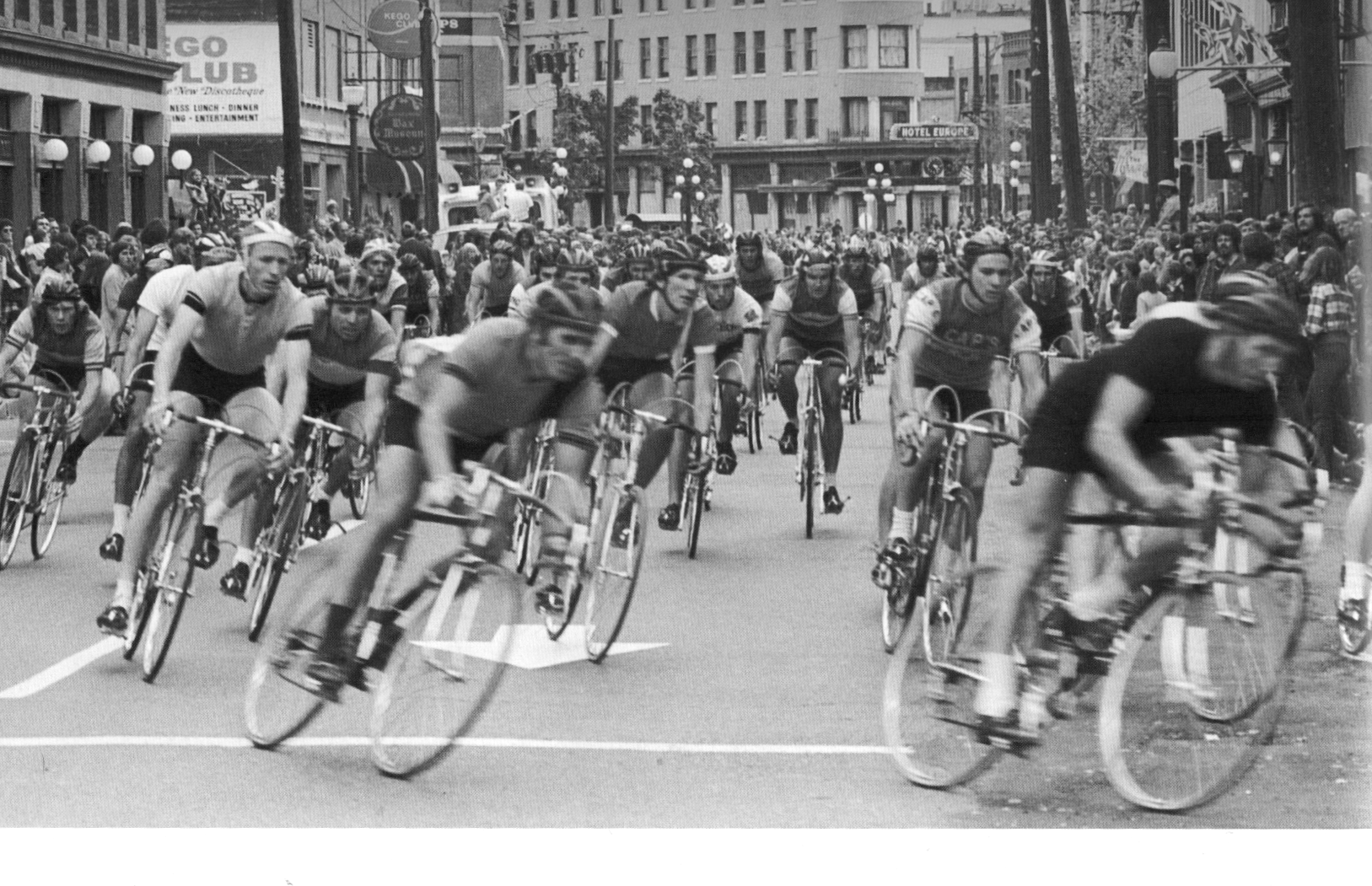
photo credit Vladimir Keremidschieff
Racers take corner in the Gastown Grand Prix, won by Coquitlam’s Bill Wild. July 22, 1973
From the book : Vancouver in the Seventies: Photos From a Decade That Changed the City, which was nominated for the 2016 British Columbia Historical Writing Award. Kate Bird.

